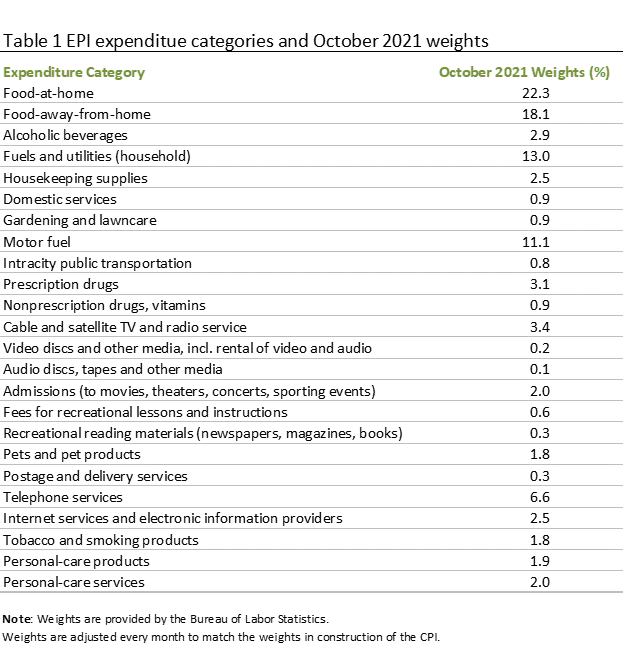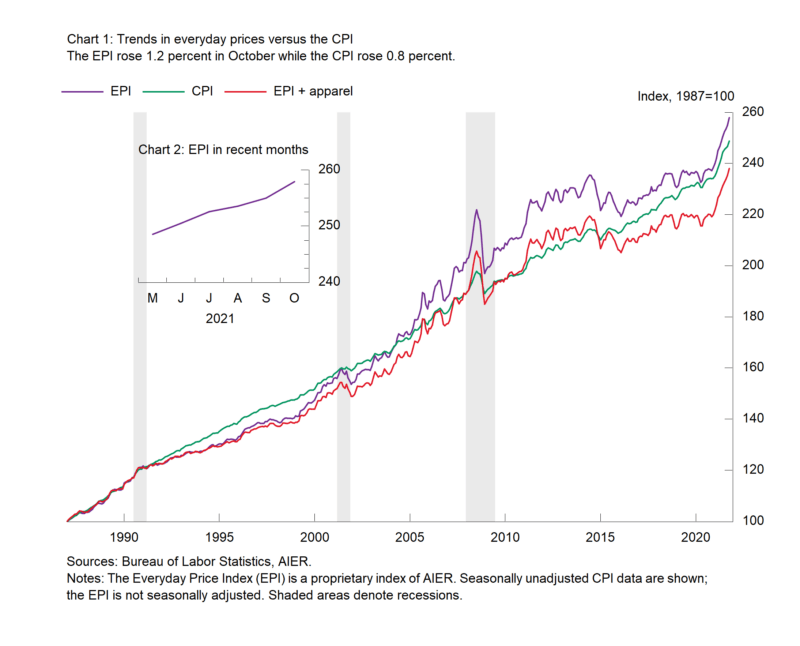AIER’s Everyday Price Index Jumps 1.2 Percent in October
The AIER Everyday Price Index jumped 1.2 percent in October, the largest monthly increase since a similar rise in March. October was the third increase of that magnitude since the start of the pandemic. The index has posted gains for eleven consecutive months and 16 of the last 18 months. Over the last 11 months, the monthly increases have been between 0.4 percent and 1.2 percent, putting the 11-month gain at 8.7 percent or an annualized pace of 9.6 percent. From a year ago, the Everyday Price Index is up 8.5 percent, the fastest pace since September 2008.
Gains were widespread with 18 of the 24 components making a positive contribution for the month. The contributions were led by motor fuel, up 3.7 percent for the month and contributing 42 basis points to the monthly gain. Food at home (a.k.a. groceries) was the second-largest contributor to the increase in October, contributing 23 basis points to the gain. Household energy was the third-largest contributor to the October increase, adding 15 basis points while food away from home (restaurants) added 15 basis points. Combined, food and energy categories have a weighting of 64.5 percent of the Everyday Price Index and accounted for 100 basis points or 87 percent of the monthly gain in October. Other large price increases were seen in postage delivery services (up 3.9 percent) and admission to events (up 3.2 percent).
The Everyday Price Index including apparel, a broader measure that includes clothing and shoes, rose 1.1 percent, also the eleventh consecutive increase. Over the past year, the Everyday Price Index including apparel is up 8.2 percent, the sixth month in a row above 6 percent and the fastest pace since September 2008. Apparel prices rose 0.7 percent on a not-seasonally-adjusted basis in October. Apparel prices tend to be volatile on a month-to-month basis, posting 12 increases and 12 decreases, ranging from -4.4 percent to 3.0 percent, over the last 24 months. From a year ago, apparel prices are up 4.3 percent.
The Consumer Price Index, which includes everyday purchases as well as infrequently purchased, big-ticket items and contractually fixed items, rose 0.8 percent on a not-seasonally-adjusted basis in October. Over the past year, the Consumer Price Index is up 6.2 percent, the fastest pace since November 1990.
The Consumer Price Index excluding food and energy rose 0.6 percent for the month (not seasonally adjusted) while the 12-month change came in at 4.6 percent, the fastest since August 1991. The 12-month change in the core CPI was just 1.3 percent in February.
After seasonal adjustment, the CPI rose 0.9 percent in October while the core increased 0.6 percent for the month. Within the core, core goods prices were up 1.0 percent in October and are up 8.4 percent from a year ago while core services prices were up 0.4 percent for the month and are up 3.2 percent from a year ago.
Among the notable increases in the core goods category were used cars and trucks (up 2.5 percent and 26.4 percent from a year ago), new vehicles (up 1.4 percent and 9.8 percent from a year ago) and tobacco products (up 1.9 percent and 8.5 percent from a year ago).
Among core services, gainers include car and truck rentals (up 3.1 percent and 39.1 percent from a year ago), lodging away from home (up 1.5 percent and 22.3 percent from a year ago), and motor vehicle repair and maintenance (up 1.5 percent and 5.4 percent from a year ago).
Price pressures for many goods and services in the economy remain elevated by lingering effects from the outbreak of Covid-19 including shortages of supplies and materials, logistical and supply chain issues, and labor problems. As activity returns to normal, supply and demand will adapt and likely lead to slower price increases, but it may take some time before the economy completely returns to normal functioning. Nevertheless, a 1970s-style upward price spiral remains unlikely.
Note: The Everyday Price Index for September is based on incomplete data due to restrictions on data collection by Bureau of Labor Statistics personnel because of the Covid-19 pandemic.







